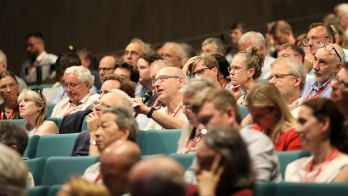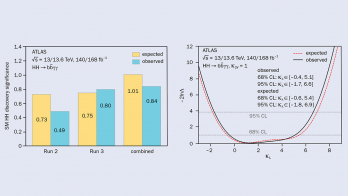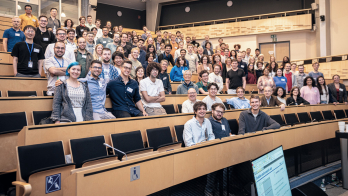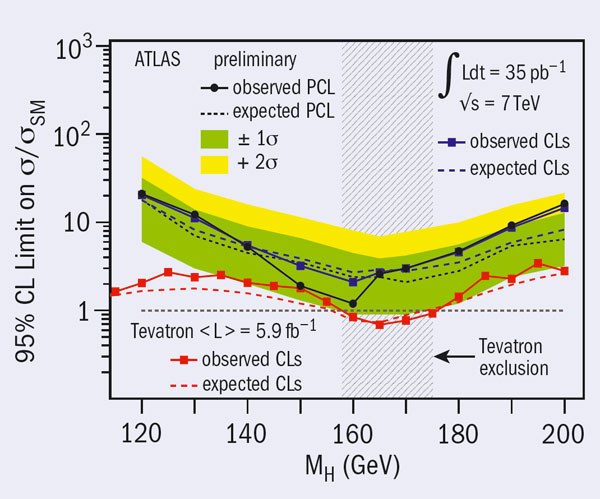
Only a few months after the end of the 2010 data taking, the ATLAS experiment is entering its discovery phase at the LHC. The collaboration has already released its first results on the full data for searches for the Higgs boson, for supersymmetry (SUSY) and for other extensions of the Standard Model. The sensitivity of these results, reported here for Higgs and SUSY, is better than expected from simulation studies made in the past, but so far none of the ATLAS searches have shown signs of new physics.
One specific example is the release of the first limits from ATLAS on the Higgs boson production cross-section in the WW decay channel, shown in figure 1 (ATLAS collaboration 2011a). Already with only 35 pb–1 of data, the best expected sensitivity is only 2.4 times that of the predictions from the Standard Model for a Higgs mass of 160 GeV, the region already excluded by experiments at Fermilab’s Tevatron. Excellent detector performance and good control of the backgrounds achieved using data-driven methods resulted in better limits than anticipated. This bodes extremely well for the 2011 run where the very good performance of the detector and analyses, combined with the predicted accelerator performance, should allow ATLAS to draw some much-anticipated conclusions on the search for the Higgs boson.
Another of the very active areas for ATLAS searches is the hunt for particles predicted by SUSY. This conceptually elegant theory predicts that for each known particle of the Standard Model, there exists a super-partner, where the partners of bosons are fermions and vice-versa. The model could also give a suitable candidate for dark matter: a stable neutral super-particle with no decays to known particles.
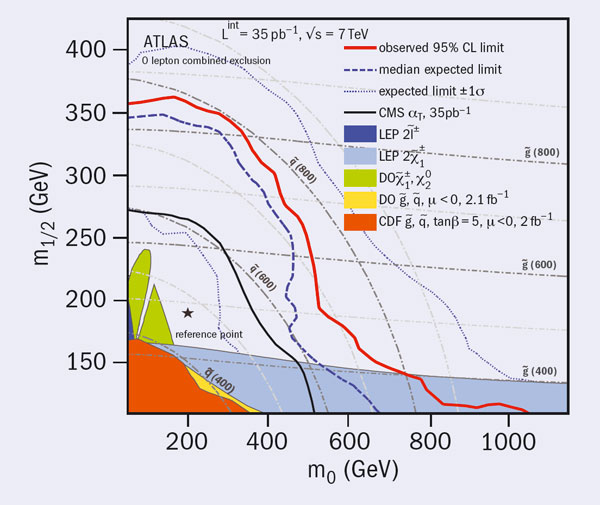
The ATLAS collaboration recently submitted its first results for SUSY searches for publication. One of these searches is in the final state with jets, missing energy and no leptons (ATLAS collaboration 2011b). To make sure no potential signal was missed in this analysis, the search was optimized and carried out combining several different signal topologies. No excess of events over the expected backgrounds is observed. The limits from this study provide the strongest constraints on the mass scales of SUSY to date (figure 2). The interpretation of these results in the minimal supergravity grand unification (mSUGRA) model excludes, at 95% confidence level, super-partners of the gluon and quarks with masses below 775 GeV, assuming they have the same mass.
ATLAS has recently completed many other analyses in the search for evidence for SUSY. These include a search with similar final states but with one (ATLAS collaboration 2011c) or two leptons, as well as a search requiring at least one jet to come from a b-quark. There are also results for searches for the super-partners of the neutrinos decaying into electron-muon final states and for stable hadronizing super-partners of quarks and gluons.
These Higgs and SUSY results are not the complete picture of ATLAS searches. A large number of topologies and final states have been studied, and limits at the tera-electron-volts scale have been set on several scenarios of new physics. These limits are in many cases the most stringent to date. The collaboration anticipates promising opportunities for discoveries with much larger data sets in 2011–2012.
Further reading
ATLAS collaboration 2011a ATL-CONF-2011-005.
ATLAS collaboration 2011b arXiv:1102.2357 [hep-ex], accepted by Phys. Rev. Lett.
ATLAS collaboration 2011c arXiv:1102.5290 [hep-ex], submitted to Phys. Lett. B.
For these results and more, see https://twiki.cern.ch/twiki/bin/view/AtlasPublic.






